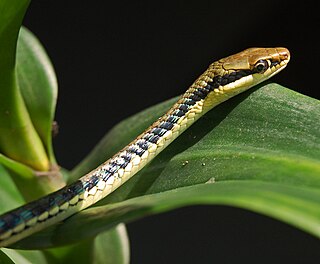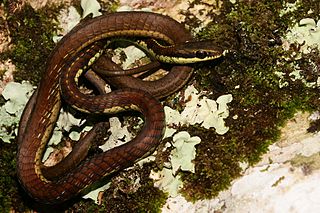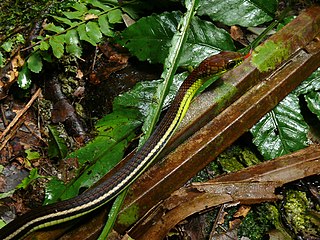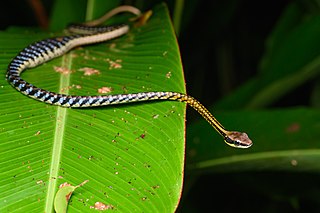
Chrysopelea, more commonly known as the flying snake or gliding snake, is a genus of snakes that belongs to the family Colubridae. They are found in Southeast Asia, and are known for they ability to glide between trees. Flying snakes are mildly venomous, though the venom is dangerous only to their small prey. There are five species within the genus.

Ahaetulla prasina is an arboreal, moderately venomous species of opisthoglyphous vine snake in the family Colubridae, found in Southern and Southeast Asia. Its common names include the Asian vine snake, Boie's whip snake, Gunther's whip snake, and the Oriental whip snake.

Dendrelaphis cyanochloris, commonly known as Wall's bronzeback or the blue bronzeback, is a species of colubrid snake found in Southeast Asia.

Dendrelaphis pictus, commonly known as either the common bronzeback, painted bronzeback, or Indonesian bronzeback, is a species of colubrid snake found in Southeast Asia.

Dendrelaphis tristis is a species of colubrid tree-snake found in South Asia.

Ahaetulla, commonly referred to as Asian vine snakes or Asian whip snakes, is a genus of colubrid snakes distributed throughout tropical Asia. They are considered by some scientists to be mildly venomous and are what is commonly termed as 'rear-fanged' or more appropriately, opisthoglyphous, meaning their enlarged teeth or fangs, intended to aid in venom delivery, are located in the back of the upper jaw, instead of in the front as they are in vipers or cobras. As colubrids, Ahaetulla do not possess a true venom gland or a sophisticated venom delivery system. The Duvernoy's gland of this genus, homologous to the venom gland of true venomous snakes, produces a secretion which, though not well studied, is considered not to be medically significant to humans.

Dendrelaphis is a genus of colubrid snakes, distributed from Pakistan, India and southern China to Indonesia, Timor-Leste, the Philippines, Australia, New Guinea and the Solomon Islands. There are over forty described species. Asian species are known commonly as bronzebacks, while the Australo-Papuan species are simply called treesnakes. All are non-venomous and entirely harmless to humans.

Dendrelaphis schokari, also known as the common bronze-back or Schokar's bronzeback, is a species of non-venomous arboreal snake in the family Colubridae. The species is endemic to Sri Lanka.

Dryophiops philippina, also known as the keel-bellied whipsnake or Philippine whipsnake, a species of rear-fanged colubrid snake that is endemic to the Philippines. One similar species, Dryophiops rubescens exists in Thailand and Malaysia.
Dendrelaphis oliveri, commonly known as Oliver's bronzeback, is a species of nonvenomous arboreal snake in the family Colubridae. The species is endemic to Sri Lanka. It is considered to be the rarest of the Sri Lankan Dendrelaphis species on account of there being only a single recorded specimen.

Dendrelaphis nigroserratus is a species of snakes belonging to the bronzebacks (Dendrelaphis). It is found only in western and southwestern Thailand and the adjacent southeastern Myanmar. A specimen has been preserved in the British Natural History Museum, London since the early 20th century. Due to its resemblance to Wall's bronzeback, the scientific name was formerly assigned under Dendrelaphis cyanochloris, the species name for Wall's bronzeback. It was formally described as a distinct species in 2012 by Gernot Vogel, Johan Van Rooijen and Sjon Hauser. According to the World Wide Fund for Nature report, it became one of the 367 important new species discovered in the Greater Mekong during 2012 and 2013.

The Ahaetuliinae are a subfamily of vine snakes within the family Colubridae that was erected in 2016. They are found from South and Southeast Asia through to Australia.

Dendrelaphis formosus, commonly known as either the elegant bronzeback or beautiful bronzeback tree snake, is a snake species in the family Colubridae from Southeast Asia.
Dendrelaphis wickrorum, commonly known as the Wickramasinghes bronzeback, is a species of arboreal snake endemic to Sri Lanka.
Dendrelaphis fuliginosus, commonly known as the Philippine lamp-black tree snake, is a species of snake in the family Colubridae. The species is found in the Philippines.

Dendrelaphis haasi, also known commonly as Haas' bronzeback, Haas's bronzeback, Haas's bronzeback snake, and Haas's bronzeback tree snake, is a species of snake in the family Colubridae. The species is native to Southeast Asia.

Dendrelaphis marenae, commonly known as Maren's bronzeback, is a species of snake in the family Colubridae, found in Southeast Asia.
Dendrelaphis ngansonensis, commonly known as either the Nganson bronzeback or Nganson bronzeback tree snake, is a species of snake in the family Colubridae, sound in Southeast Asia.

Dendrelaphis striatus, commonly known as the banded bronzeback or striated bronzeback treesnake, is a species of snake of the family Colubridae found in Southeast Asia.

Dendrelaphis subocularis, commonly known as the mountain bronzeback or Burmese bronzeback, is a species of snake in the family Colubridae from Southeast Asia.

















